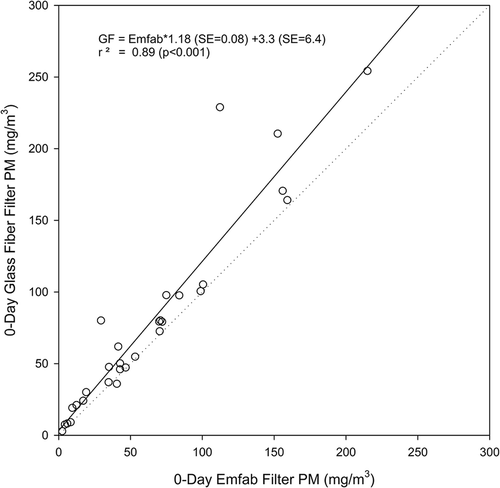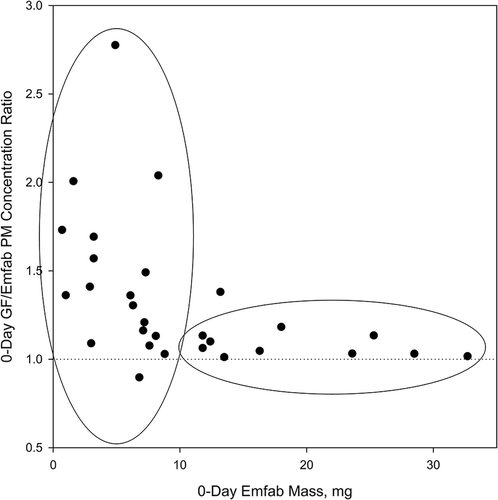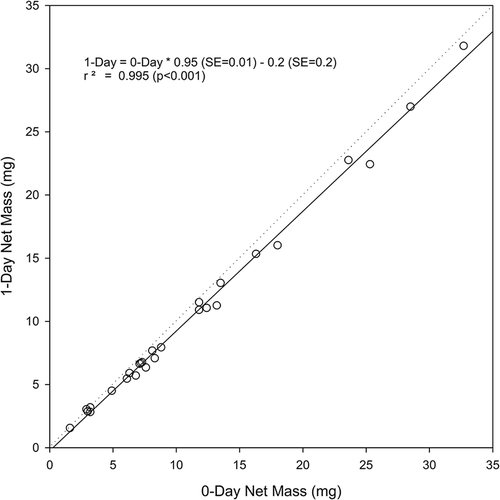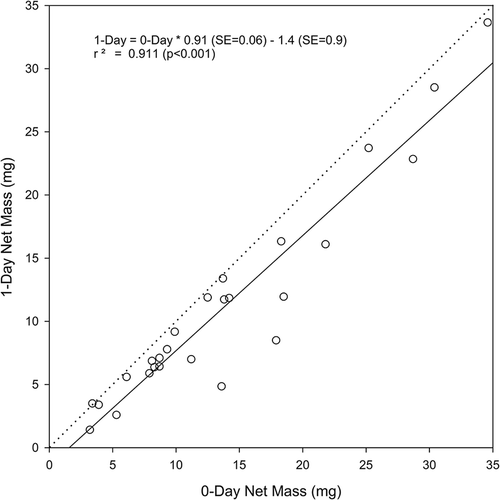ABSTRACT
The performance of Teflon-coated glass fiber filter media (Pallflex Emfab TX40) is evaluated for particulate matter (PM) sampling of residential wood heating devices in a dilution tunnel. Thirty samples of varying duration and PM loading and concentration were collected from an U.S. Environmental Protection Agency (EPA) Method 28 dilution tunnel using dual Method 5G sample trains with untreated glass fiber and Emfab filters. Filters were weighed soon after the end of sampling and again the next day after equilibration at 35% relative humidity (RH). PM concentrations from both types of filters agreed very well with 1-day equilibration, demonstrating that Emfab filters are appropriate for use in measuring PM from residential wood burning appliances in a dilution tunnel and have performance equal to or better than the glass fiber filter media. Agreement between filter media without equilibration was erratic, with PM from glass fiber filter samples varying from slightly less than the Emfab samples to as much as 2.8 times higher. Some of the glass fiber filters lost substantial mass with equilibration, with the highest percent loss at lower filter mass loadings. Mass loss for Emfab samples was a small percentage of the mass and very consistent across the range of mass loadings. Taken together, these results may indicate water uptake on the glass fiber media that is readily removed with 1-day equilibration at moderate RH conditions.
Implications: EPA regulations now allow the use of either glass fiber or Teflon filter media for wood appliance PM emission testing. Teflon filter media minimizes the potential for acid-gas PM artifacts on glass fiber filters; this is important as EPA moves toward the use of locally sourced cordwood for testing that may have higher sulfur content. This work demonstrates that the use of Teflon-coated glass fiber filters can give similar PM measurement results to glass fiber filters after 1 day of equilibration. With no equilibration, measured PM from glass fiber filters was usually higher than from Teflon-coated glass fiber filters.
Introduction
Woodsmoke from residential wood heating plays an important role in ambient air quality. It is the fourth largest source category of particulate matter (PM) emissions, accounting for 15% of U.S. PM emissions and 5 times more than U.S. petroleum refineries, cement manufactures, and pulp and paper mills combined (U.S. Environmental Protection Agency [EPA], 2013). In many nonurban areas, residential wood heating PM emissions exceed emissions from all industrial, commercial, and institutional heating fuels and transportation combined and accounts for 50% of all area source air toxic cancer risks (EPA, 2015). In an effort to reduce exposure to woodsmoke, PM emission standards for residential wood heating devices were made more stringent as part of the EPA 2015 revisions to the New Source Performance Standards for New Residential Wood Heaters (2015 NSPS). The 2015 NSPS also specifies a modified test method that allows but does not require use of Teflon membrane or Teflon-coated glass fiber filter media instead of glass fiber filters without a binder for dilution tunnel PM sampling (EPA, Citation2015). Additional incremental changes to the test method will be phased in over several years, as described in EPA’s “Process for Developing Improved Cordwood Test Methods for Wood Heaters” (EPA, Citation2016). This rule also announced EPA’s intention to move from Douglas fir crib-wood (dimensional lumber) testing to cordwood testing to better reflect PM emissions of wood heaters in real-world residential use.
The use of Teflon or Teflon-coated filter media for wood heater PM emissions testing is consistent with the EPA Method 5, Section 7.1.1 (EPA, Citation1971) requirement to use filter material that is unreactive to acid gases for sources that may contain sulfur dioxide (SO2), sulfur trioxide (SO3), or other reactive gases. The Method 5 Frequently Asked Questions document states: “The reaction of gaseous compounds such as SO2 and SO3 with filter media can result in large positive errors in mass on the filters. As the amount of particulate matter sampled using Method 5 decreases, it becomes increasingly important to ensure filter materials are unreactive to the constituents of the sample matrix.”
Possible acid gas PM artifacts from the use of glass fiber filter media were not considered under the 1988 NSPS. This may in part be because the 1988 test method uses Douglas fir as the only test fuel, and the range of Douglas fir is limited to the western United States, where wet deposition of sulfate (and thus the sulfur content of the wood) is low (U.S. Geological Survey [USGS], Citation2015; National Atmospheric Deposition Program [NADP], Citation2001). EPA-certified testing facilities are located throughout North America and Europe; since many states have enacted regulations limiting the transport of untreated cordwood for disease control, a transition to a test procedure that uses cordwood under the 2015 NSPS will require a test fuel that can be sourced within close proximity to the testing location. Woods grown in the eastern United States can have sulfur concentrations in excess of 100 ppm on a weight basis (w/w) (Chandrasekaran et al., Citation2012), and emissions could contain SO2 or SO3 (Sippula et al., Citation2007; Tissari, et al. Citation2008). It is well documented that the alkaline glass fibers can react with acid gases such as SO2 or SO3, and also hydrochloric acid (HCl), nitrous oxide (NO2), nitric acid (HNO3), or any other acid gas potentially present in the sample stream to form a positive PM artifact (EPA, Citation1996, Appel et al., Citation1984; Coutant, Citation1977; Lipfert, Citation1994; Lodge, Citation1989; Mueller et al., Citation1983; Pierson et al., Citation1976; Spicer and Schumacher, Citation1977; EPA, 1971). Therefore, the use of glass fiber filters, especially with a species other than Douglas fir, has the potential to introduce artifacts to the PM certification values and an alternative media such as Teflon or Teflon-coated filters should be required.
To evaluate the applicability of Teflon filter media for use in the 2015 NSPS, this study compares the performance of Teflon-coated glass fiber filter media (Pallflex Emfab TX40 filters; Pall Life Sciences, Ann Arbor, MI) with the performance of the glass fiber filters required by Method 5G for PM sampling of residential wood heating devices in a dilution tunnel.
A Teflon-coated glass fiber media such as Emfab has several advantages over glass fiber:
It is an inert media (no acid gas artifacts).
When the sample gas stream has high relative humidity at the filter temperature, Teflon-coated fibers are less likely to adsorb water than glass fibers.
Teflon-coated fibers may also help minimize sticking of the filter material to the filter holder O-ring during post sample disassembly of the filter holder.
Emfab media has filtration specifications similar to the glass fiber filter media currently used for EPA Method 5G (EPA, Citation1988); the filtration efficiency is 99.95% (Pall Corporation, 2017). The cost is higher than glass fiber filters but less than U.S.$2 per filter.
Methods
Thirty collocated samples of woodsmoke PM were collected from an EPA Method 28 dilution tunnel during February 2015 at the Brookhaven National Laboratory (BNL) in Upton, New York. One sample train used 47 mm diameter glass fiber filters (no binder) as specified in EPA Method 5G; the other used 47 mm Emfab filters. - in Method 5G (EPA, Citation1988) shows the sample train components. Sample durations ranged from 15 to 64 min. Sample flows were 0.20 cubic feet per minute (CFM) (5.7 liters per minute [LPM]), and tunnel flow was approximately 425 CFM. Most of the tests used a 1988 NSPS noncatalytic wood stove as the woodsmoke source, burning cordwood from a variety of local hard- and soft-wood species over a range of burn rates and conditions (start-up, steady state, etc.). With the exception of two wood stove runs of green pine (freshly cut, moisture not recorded), all wood was within the moisture range required by Method 5G (19–25%). Five of the runs used a low-mass downdraft wood boiler with auxiliary thermal storage and relatively low PM emissions, burning red oak cordwood.
Figure 3. 1-Day glass fiber filter PM concentration versus 1-day Emfab filter PM concentration (mg/m3).
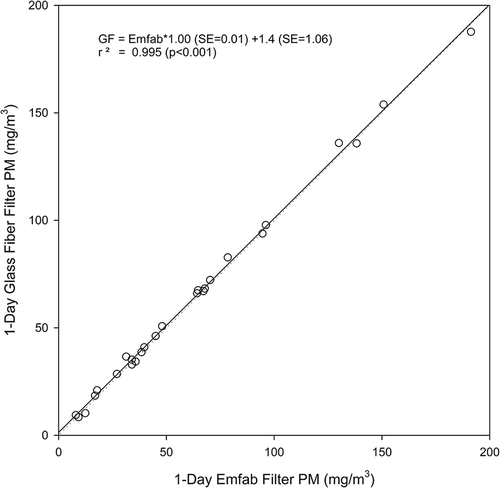
For this analysis, only the PM mass from the front filter was used; back-filter mass and probe catch PM mass are not included. Initial filter weighings were done at BNL after dessication and using a 0.1 mg resolution balance, and also at the Connecticut Department of Energy and Environmental Protection (CT-DEEP) laboratory after equilibration at 35% relative humidity (RH) and using a 0.001 mg resolution balance to improve precision at low mass loadings. Filters were weighed at BNL soon after the end of sampling with no equilibration (0-day weights). Filters were then stored and shipped cold to the CT-DEEP laboratory for the 1-day and 1-week (6–7 days) filter weighings, with equilibration at ~35% RH instead of the very low RH (desiccation) equilibration used for Method 5G (35% RH is the humidity used for equilibration of ambient federal reference method filter PM samples). Note that the 1-day and 1-week net filter mass data (done with a 0.001 mg resolution balance) are more precise than the 0-day data (done with a 0.1 mg resolution balance) for samples when filter mass loading is less than 5 mg.
Comparisons between the glass fiber and Emfab filter sample trains were done using PM concentrations to account for possible differences in sampled volumes. Comparisons of mass loss over time for each filter media type were done using the filter net PM mass measurements.
Results
The agreement between glass fiber and Emfab filter 0-day PM concentrations was highly variable. A scatter plot is shown in ; the ordinary least squares regression slope is 1.18 (SE = 0.078), a nonsignificant intercept of 3.3 (SE = 6.4, P = 0.61), and an adjusted R2 of 0.89 (P < 0.001). The four lowest PM concentrations are from the downdraft cordwood boiler, a relatively clean burning device. With one exception, PM concentrations from glass fiber filters were higher than or equal to PM concentrations from Emfab filter samples. Ratios of PM concentrations measured with glass fiber to those measured with Emfab filters were greater than 1.3 for 11 of the 30 samples, and the ratio for 3 samples was greater than 2. Higher ratios are generally at lower 0-day Emfab filter loadings, as shown in .The average of the ratios for samples with more than 10 mg Emfab filter PM loading is 1.10; for samples with less than 10 mg loading, the average ratio is 1.45. The eight highest ratios all have loadings less than 10 mg. Some scatter at lower filter mass loadings may be due to the use of a 0.1 mg resolution balance for the 0-day filter weights. The single sample with glass fiber filter PM concentration lower than Emfab filter PM (ratio of 0.89) was a relatively low filter mass loading of 7 mg, and balance resolution may account for some of this anomalous result.
In contrast to the 0-day weighing data, there was excellent agreement between glass fiber and Emfab PM concentrations for 1-day weighings done with a 0.001 mg resolution balance ().(SE = 0.01), with a nonsignificant interceThe regression slope is 1.00 pt of 1.4 (SE = 1.0, P = 0.21) and with R2 = 0.995 (P < 0.001); this high coefficient of determination indicates that there was minimal effect on filter performance across the different devices and woods used.
The filter mass lost between 0-day and 1-day weighings for each filter media is shown in (Emfab) and (glass fiber).Mass loss for the Emfab filters was smaller (5%) and much more consistent across samples, with an R2 of 0.995 (P < 0.001). Some of the glass fiber filters lost as much as two-thirds of their mass after 1-day equilibration at 35% RH, whereas some lost little to no mass; R2 is 0.91 (P < 0.001).
Discussion
The erratic and sometimes very large percent mass loss for glass fiber filter samples between 0-day and 1-day filter weighings (with equilibration at 35% RH) suggests that there may be water uptake on the glass fiber media. Mass loss during equilibration is likely a combination of semivolatile organic compounds (SVOCs) and water from particles or the filter media. However, for those samples that lost a large percentage of mass, the small and consistent mass loss from the Emfab filters over 1 day of equilibration suggests that water loss may be dominant, since it is a reasonable assumption that the type of filter media does not have a large effect on loss of SVOCs between 0-day and 1-day filter weights. Water loss from the glass fiber media (not the particles on the filter) is consistent with the larger percent mass loss occurring at lower filter mass loadings. Given the range of burn conditions, the amount of water vapor in the stack gas would be expected to be substantially variable. RH data at the sample filter might help explain the mass loss variability as water related, but that was not measured. The excellent agreement between observed glass fiber and Emfab PM concentrations after 1 day of equilibration shows that Emfab is a suitable media for capturing particles from wood combustion emissions in a dilution tunnel.
This may be important when testing uses fuels that can contain sulfur, including the red oak that must be used in testing wood boilers and alternative test methods such as American Society for Testing And Materials (ASTM, Citation2013) E2618 that allow the use of a variety of wood species. Emfab filters have sufficient loading capacity for use with this test method; the largest filter mass loading for these samples was 32 mg (1-day weighing).
Although the erratic 0-day PM from glass fiber filters is not an issue with current test methods that require equilibration with desiccation until the filter mass stabilizes, it could present problems if it can be shown that mass loss from Emfab filters during equilibration is driven by SVOC loss. This could also be an issue if continuous PM methods are considered for use in dilution tunnel measurements, since by definition a continuous method is equivalent to a 0-day (no equilibration) filter weighing. Preliminary work comparing a 30 °C Teom (an Emfab filter–based true mass measurement) with Method 5G filter pulls using Emfab media is in progress and will be reported in a future publication.
Given the excellent agreement between glass fiber and Emfab PM levels after 1 day of equilibration, there was no evidence of acid gas artifacts in these samples. This study was not designed to directly assess acid gas artifacts, which would be largest with clean burns that produce minimal PM. Although the wood stove used for most of these samples is EPA certified at 1.6 g/hr, actual PM emissions for these tests ranged from 6 g/hr for a steady-state cordwood burn to 140 g/hr for a cold-start 15-min sample; the median emission for all wood stove tests was 47 g/hr.
Conclusion
Since PM from residential heater woodsmoke is a significant portion of the PM emission inventory in many areas of the United States, it is important to move towards cleaner burning devices. The 2015 revisions to the NSPS are an important step in this direction. The use of Emfab filters for PM sampling in wood heater certification tests should become an integral part of those revisions. This is consistent with the EPA Method 5 requirement that inert filter media should be used for these measurements. This work demonstrates that Emfab filters are appropriate for use in measuring PM from residential wood burning appliances in a dilution tunnel, and perhaps preferable to the glass fiber filter media that has been in use for many years for test methods such as EPA Method 5G. Although PM concentrations determined using glass fiber filters agreed well with those determined using Emfab filters after 1 day of equilibration, the glass fiber filters may sometimes have had substantial water uptake when filter mass is measured soon after sampling is completed (0-day filter weighings). Although this is not an issue with current test methods, the water uptake could present problems if it is determined in the future that mass loss during equilibration of Emfab filters is driven by SVOCs, and that 0-day or 1-day PM is a more appropriate metric for characterization of PM emissions.
An important research need related to this area of work is to better understand to what extent water and SVOCs drive mass loss during equilibration when Emfab filter media is used. Additional work to better determine the potential for water uptake on glass fiber filters could include measurement of RH at the filter (or RH and temperature in the dilution tunnel and accurate measurement of filter temperature, to calculate RH at the filter). Running a back filter for each sample (instead of a single back filter for several sample runs) and using a 0.01 or 0.001 mg resolution balance would also provide useful diagnostic information.
Funding
This work was funded by the New York State Energy and Development Authority (NYSERDA), Agreements No. 32964 and 63019. The Connecticut Department of Energy and Environmental Protection provided filter weighing services.
Additional information
Funding
Notes on contributors
George Allen
George Allen is a senior scientist at NESCAUM, in Boston, MA.
Lisa Rector
Lisa Rector is a senior policy analyst at NESCAUM, in Boston, MA.
Thomas Butcher
Thomas Butcher is a group leader at Brookhaven National Laboratory, Energy Conversion Group, Upton, NY.
Rebecca Trojanowski
Rebecca Trojanowski is staff engineer at Brookhaven National Laboratory, Energy Conversion Group, Upton, NY.
References
- ASTM E-2618-13 2013. Standard Test Method for Measurement of Particulate Emissions and Heating Efficiency of Solid Fuel-Fired Hydronic Heating Appliances. ASTM, West Conshohocken, PA https://www.astm.org/Standards/E2618.htm (accessed August 23, 2017)
- Appel, B.R., Y. Tokiwa, M. Haik, and E.L. Kothny 1984. Artifact particulate sulfate and nitrate formation on filter media. Atmos. Environ. 18:409–16. doi: 10.1016/0004-6981(84)90116-1.
- Chandrasekaran, S. R., G. A. Allen, P. K. Hopke, L. Rector, and L. Lin. 2012. Chemical composition of wood chips and wood pellets. Energy Fuels 26:4932–7. doi: 10.1021/ef300884k.
- Coutant, R. 1977. Effect of environmental variables on collection of atmospheric sulfate. Environ. Sci. Technol. 11:873–8. doi: 10.1021/es60132a008.
- Lipfert, F. W. 1994. Filter artifacts associated with particulate measurements: Recent evidence and effects on statistical relationships. Atmos. Environ. 28:3233–49. doi: 10.1016/1352-2310(94)00167-J.
- Lodge, J. 1989. Methods of Air Sampling and Analysis, 3rd ed.., 428, Section 3.4, Lewis Publisher Inc., Chelsea, Michigan.
- Mueller, P., G. Hidy, R. Baskett, K. Fung, R. Henry, T. Lavery, K. Warren, and J. Watson. 1983. The Sulfate Regional Experiment: Report of Findings. Report EA-1901. Palo Alto, CA: Electric Power Research Institute. http://views.cira.colostate.edu/improve/Publications/epri_reports.htm ( accessed August 27, 2017).
- National Atmospheric Deposition Program. 2001. 2000 annual summary, NADP Data Report 2001-01. http://nadp.sws.uiuc.edu/lib/data/2000as.pdf, page 5 ( accessed August 27, 2017).
- Pierson, W., R. Hammerle, and W. Brachaczek. 1976. Sulfate formed by interaction of sulfur dioxide with filters and aerosol deposits. Anal. Chem. 48:1808–11. doi: 10.1021/ac50006a042.
- Rehfeldt, G.E., N.L. Crookston, M.V. Warwell, and J.S. Evans. 2006. Empirical Analyses of Plant-Climate Relationships for the Western United States. Int. J. Plant Sci. 167(6):1123–50. doi: 10.1086/507711.
- Sippula, O., K. Hytönen, J. Tissari, T. Raunemaa, and J. Jokiniemi. 2007. Effect of wood fuel on the emissions from a top-feed pellet stove. Energy Fuels 21:1151–60. doi: 10.1021/ef060286e.
- Spicer, C. W., and P. M. Schumacher. 1977. Interference in sampling atmospheric particulate nitrate. Atmos. Environ. 11:873–6. doi: 10.1016/0004-6981(77)90062-2.
- Tissari, J., J. Kouki, O. Sippula, K. Vuorio, and J. Jokiniemi. 2008. Fine particle and gas emissions from the combustion of agricultural fuels fired in a 20 kW burner. Energy Fuels 22:2033–42. doi: 10.1021/ef700766y.
- U.S. Environmental Protection Agency. 1996. Air Quality Criteria for Particulate Matter, Volume I. EPA/600/P 95/001aF. http://ofmpub.epa.gov/eims/eimscomm.getfile?p_download_id=219820 (accessed August 27, 2017).
- U.S. Environmental Protection Agency. 2016. Process for developing improved cordwood test methods for wood heaters. https://www.epa.gov/burnwise/process-developing-improved-cordwood-test-methods-wood-heaters (accessed August 27, 2017).
- U.S. Environmental Protection Agency. 1971. Method 5. Determination of Particulate Matter Emissions from Stationary Sources. https://www.epa.gov/emc/method-5-particulate-matter-pm (accessed August 27, 2017).
- U.S. Environmental Protection Agency. 1988. Method 5G. Determination of Particulate Matter Emissions from Wood Heaters. https://www.epa.gov/ttnemc01/promgate/m-05g.pdf (accessed August 27, 2017).
- U.S. Environmental Protection Agency. 2013. 2011 National Emissions Inventory. https://www.epa.gov/air-emissions-inventories/2011-national-emission-inventory-nei-report (accessed August 27, 2017).
- U.S. Environmental Protection Agency. 2015. 2011 National Air Toxics Assessment. https://www.epa.gov/national-air-toxics-assessment/2011-nata-assessment-results (accessed August 27, 2017).
- U.S. Environmental Protection Agency. 2015. Standards of performance for new residential wood heaters, new residential hydronic heaters and forced-air furnaces. Fed. Regist. 80:50–13672-753. https://federalregister.gov/a/2015-03733 (accessed August 27, 2017).
- U.S. Geological Survey, Geosciences and Environmental Change Science Center. 2015. Digital representations of tree species range maps. http://wayback.archive.org/web/20170722104907/https://esp.cr.usgs.gov/data/little/ (accessed August 23, 2017).

